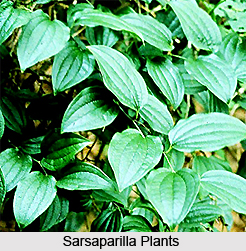Indian Sarsaparilla is a perpetual, winding or creeping herb, with a woody aromatic rhizome. It has a lean, hairless stem, uneven dark green leaves, greenish flowers in petite thickset bunches and tapered cylindrical fruits. The dried roots make up the drug.
 The plant has been referred to as a significant medicine in ancient Indian literature. In 1864 it was included in the British Pharmacopoeia.
The plant has been referred to as a significant medicine in ancient Indian literature. In 1864 it was included in the British Pharmacopoeia.
On simple distillation with water, the roots produce a steroptency, which is supposed to be an explosive acid. It also contains a volatile oil. The smell of the drug comes from coumarin. The roots also contain resins, tannin and glycoside.
Methods of usage
Indian sarsaparilla comes to everyday disordered use, like stomach ailment, genital malfunction; fever, swelling due to rheumatism or hair vitaliser.
Healing Power and Medicinal Properties of Indian sarsaparilla
The roots are a syrupy revitaliser and implement a comforting effect on the skin and mucous membranes. They are valuable in disciplining disorders due to undernourishment, purify blood, boost flow of urine and reinstate regular body functions.
Stomach Disorders cured by Indian sarsaparilla
Indian sarsaparilla is advantageous for remedying stomach disturbances, like dyspepsia and loss of appetite. The pulverisation of the roots is administered in dosages of 1 to 6 grams with milk in these conditions. The roots- mashed to a paste with water and blended with pepper is beneficial in stomach-ache and diarrhoea.
Genito-Urinary Disorders healed by Indian sarsaparilla
The herb is exceedingly beneficial in instances of syphilis, leucorrhoea and other genito-urinary disorders. A decoction of its roots must to be given in 60 to 90 ml dosages, thrice daily A syrup made from its roots also acts as an effective diuretic.
Fevers healed by Indian sarsaparilla
The drug is of ample use in the treatment of fevers. Its diaphoretic properties, i.e., sweat stimulating properties, hasten abundant perspiration, in the process reducing body temperature.
Inflammation cured by Indian sarsaparilla
A paste of its roots is administered locally to treat inflammations, rheumatic joints and boils.
Methods for Uses and Dosages
Pulverisation of the roots which are small and black, must be applied to tea or syrup. Approximately 30 to 60 grams of the root pulverisation can be utilised. Adding up of rose petals, lotus petals, milk and honey or palm sugar to the decoction, renders it a freshening summer cooler.
Other Uses of Indian sarsaparilla
Hair Tonic - The herb contains a hair-stimulating hormone. A decoction of the root, used as a hair wash, boosts hair growth.











